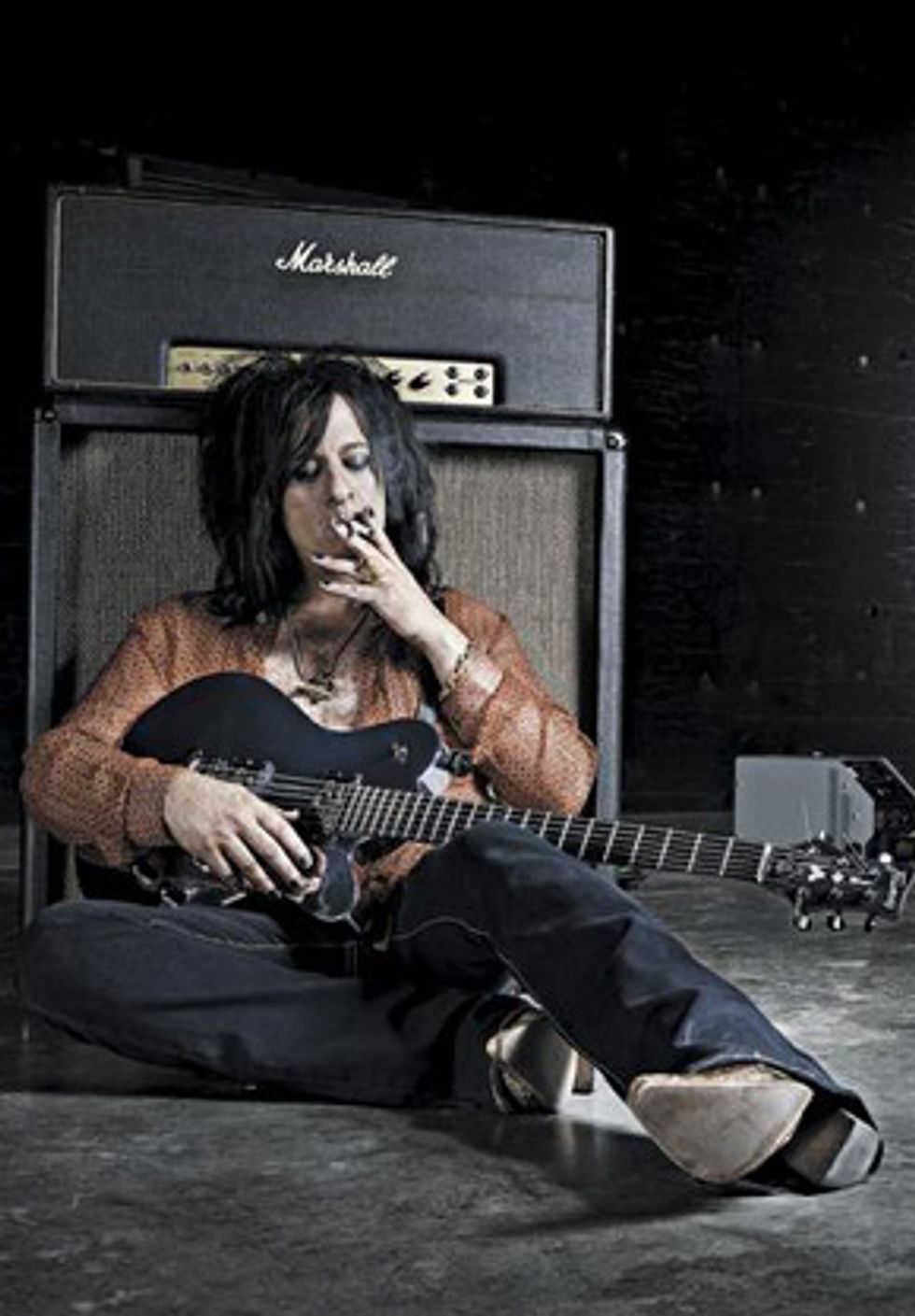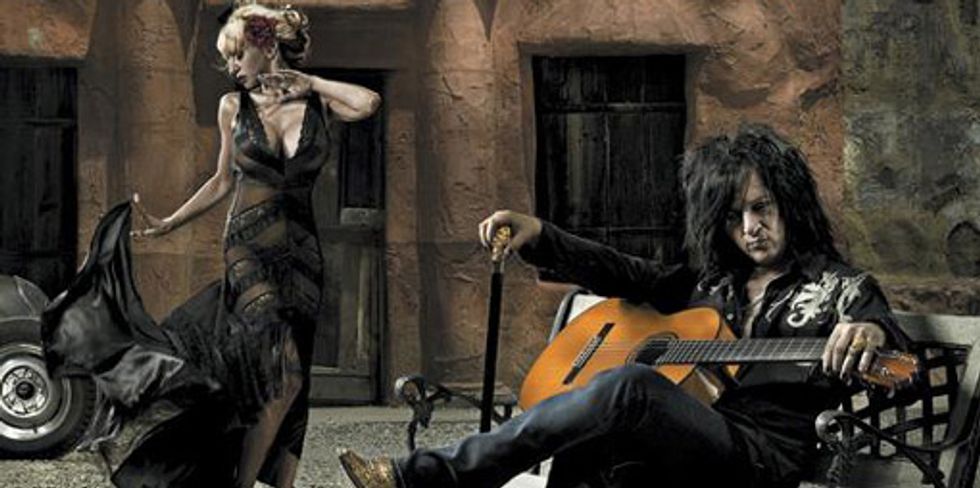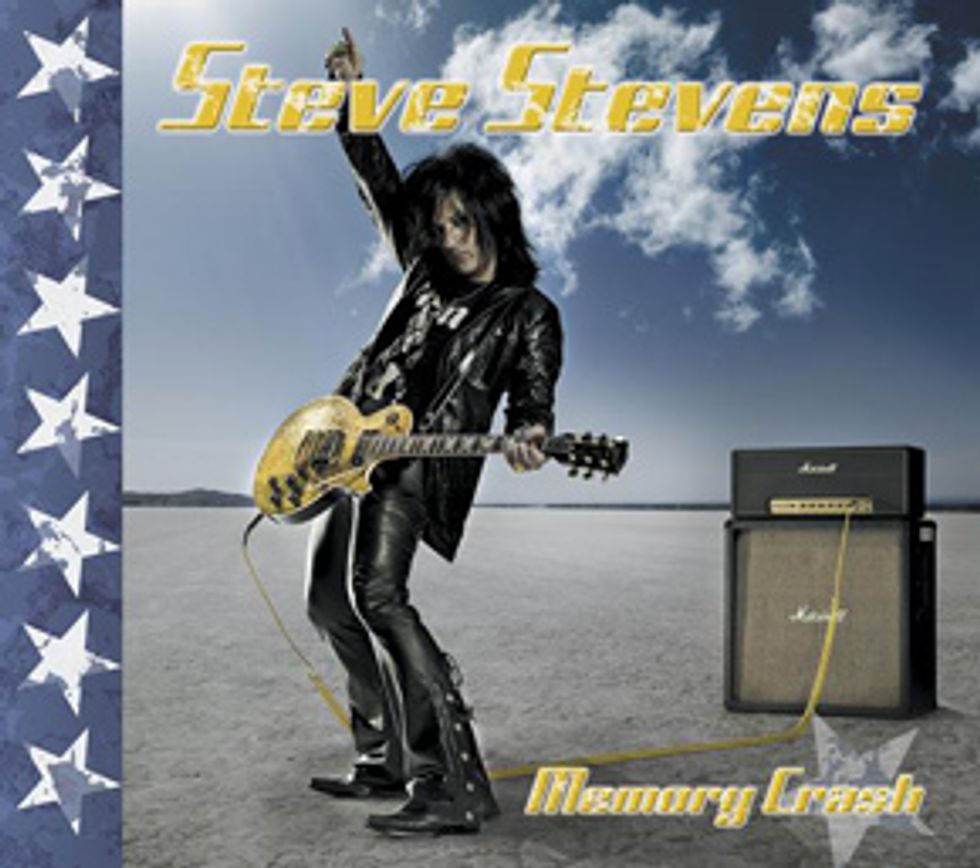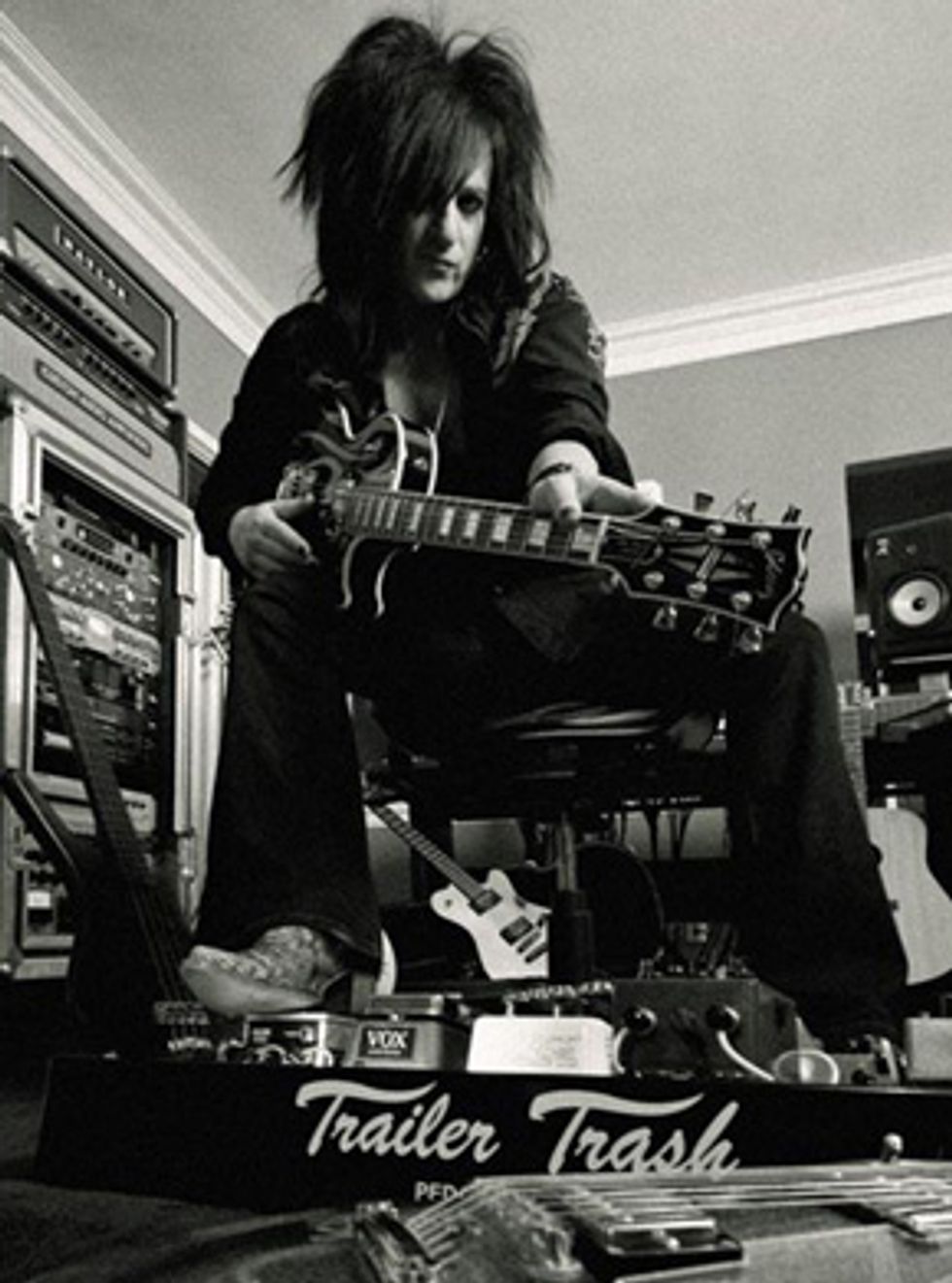|  |
Stevens'' hooks are more memorable than the iconic ones Billy Idol threw with his left hand in video after video. His tones have a certain bright, full-body signature to them that is identifiable, yet fitting for the project at hand, regardless of whether he is rocking, backing, complimenting visuals on the silver screen or stirring emotions with nylon strings
Needless to say, we were stoked to hear Stevens’ latest disc, Memory Crash. His first solo effort in eight years, the album delivers the fist-pumping grooves you expect from Stevens while taking you on an expedition of sounds that are a true kick in the ass. The impact comes from his ability to craft sonic textures as well as deliver mind-bending notes and runs.
Due out March 4th, you can preview some tracks at Stevens’ myspace page, but trust us – the way the full-quality CD punches you in the chest and takes you for a ride, this is a record you have to spin in order to fully appreciate.
We recently caught up with our friend to pick his brain about Memory Crash and his gear.
Steve, what have you been up to?
I took about the last eight months to do this record and now that I’m finished, I’m back to doing Billy Idol stuff. We have a new Greatest Hits record coming out that will have four new tracks on it. We head out on tour to support that in June and then there’s an all new Billy Idol record after that.
That’s exciting. Tell me about Memory Crash and the concept behind it.
Well, I was approached by Magna Carta records – and I’m not really that hip on guitar instrumental records, I don’t listen to them a lot – so I said send me some of the things that you’ve done. Obviously that label is known for a lot of that, and they sent me a lot of stuff that was very shreddy.
That''s Mike Varney’s thing, right?
Yeah, exactly. So I started thinking about it and you know, as of this year it’s been 40 years for me since I picked up the guitar, so what I thought I’d try to do with this record is hopefully express the stuff that excited me when I was just starting … I started getting really excited about players that made a huge impact on me when I first started. I surrounded myself with as many different guitars, old effects pedals and old amps as I could, and wanted to buck the trend and do a record that expressed a lot of different guitar styles – guitarists that maybe people don’t initially think of when they hear my guitar playing, like David Gilmour.
I started seeing stuff about him playing pedal steel on Dark Side of the Moon so I got on eBay and bought an old pedal steel and learned how to play it, and that kind of dictated the direction of the record. I’ve always felt that the great records that I bought immersed you in something. So I wanted to build a lot of segues and things into the record. You know, I didn’t really care about how long a song was. If it was eight minutes then, that’s cool.
I’d love to know, and I’m sure our readers would too, who some of those players are in addition to Gilmour.
At the time that I started playing, it was the early seventies. That’s when you had all the brilliant prog rock guitar players, like Robert Fripp and Steve Howe, who was just starting, and Brian May came along, so I’d say the majority of them were from the early seventies. Robin Trower. Steve Hackett from Genesis. For those guys it was a different time. Musically, bands were expected to be adventurous and produce concept records. You know, have one song per album side. So, I thought – well, if ever I’m going to do a record like that, now’s the time.
This album is so well-rounded. It’s cool to hear you talk about exploring Gilmour and lap steel and doing all these things, yet you’ve still got your ray gun signature thing happening. It’s a cool mix but I’ve also noticed that as you run the gamut of all these things there’s still a consistency there. It really works.
Yeah, the one thing that really came out in this record is a very strong Hendrix vibe. It’s not something that I planned. When I did [the track called] "Cherry Vanilla," it was like I was just digging on some Hendrix stuff and for me that’s a new thing, having that kind of sound and playing a Strat. That’s certainly not something that I’m known for. For the entire record I tuned down a half step only because a lot of my favorite guitars players did that. I dug the sound of it. It gives the guitars a sort of weight that you don’t get with standard tuning.
It’s cool with that song in particular. It’s such a mean, groovin’ blues. It’s really working. We get to hear you kind of stretch out and get more organic with your playing.
Thanks. You know, I think after 40 years, the one thing that I’ve gotten better at and concentrated on is really developing a great vibrato. And you know, back in the eighties there was no time for vibrato. Everything was about playing 168 bpm and chunking eighth notes. But all of my favorite players, you could identify them just by their vibrato.
Let’s talk about what you used on the record and how you got those sounds.
It’s a good combination of old stuff and new -- one of the amps that I got was a Victoria Regal. Basically, I didn’t want to pay six grand for an old Supro just because everybody says Jimmy Page used it on the first Led Zeppelin record.
Sure. If it’s in the studio and already there, you’re happy to plug into it, but…
Exactly. I think there are a lot of manufacturers and people who make gear now that is as good as the old stuff and possibly even better. One of the things that I did do, on the second track, “Hell Cats Take the Highway,” I used a tiny little amp, it’s called a Rex and it’s made by Valco. It’s got a tiny little Jensen speaker, it’s not even round, it’s one of those kind of elliptical speakers. I got that off eBay. I think I paid about $250 for it.
You’re such a gear whore. I love it!
Yeah, man! It’s like this tiny little amp and I put a mic in front of it -- I was trying to capture those early Led Zeppelin/Yardbirds sounds. So I just plugged one of my Les Pauls into it and that was the sound. I tracked the entire song with that one amp. I just thought, if I’m gonna try to capture that whole era, that was the sound: very small amps turned all the way up. There were only volume and tone controls on that amp and it was cool.
If you think back on a lot of great guitar records, a lot of really big guitar sounds were created with small amps, just dimed out. But I’m sure that at some point you had your old Marshalls and things like that flying around.
Yeah, the amp that I recorded "Rebel Yell" with was an old Marshall, not a plexi but a’71 metal face and that amp had been shelved. It was really my workhorse. It was an amp that I had years before joining up with Billy Idol. I recorded "Rebel Yell" with it and then for some reason it had stopped working and I left it in storage. You know, I had acquired plexis and stuff by then. But the guy who does all my gear, Dave Freeman at Rack Systems, started talking with me about modding one of my amps because he’s learned a number of things, especially since he works on Eddie Van Halen’s gear and he’s seen the early amps that Van Halen recorded the early stuff with. And he said there’s no big mystery to that particular amp [sound], he could do that to one of my amps. So I was like, "Done deal! Take that amp that’s not working."
When I got it back from him I was amazed by the sound of it. It didn’t have any added gain stages to it; there was no big mystery to it. It was just a couple of resistors changed. He suggested running on a Variac and lowering the voltage. There’s one particular solo on the record, on a song called “Small Arms Fire,” where you hear it and go, “Wow, that sounds like early Van Halen” and it is that Marshall.
Tell me about some of the pedals you used.
There are a number of pedals that were built for me by Theo Hartman of Hartman Electronics. He sent me his fuzz boxes. He’s got this [OC44] Vintage Germanium Boost pedal -- it’s basically a treble booster and I used that with some of the small amps to push them. I also got some stuff from Retro-Sonic. There’s a phaser pedal that he does which, to me, is even better than the old MXR script pedal. For other boost stuff I’d use that pedal from Creation Audio Labs [the MK.4.23 from Creation Audio Labs].
Yeah, some guys find the MK.4.23 too transparent, but I think that’s a great boost.
It’s great. It just makes your guitar louder. So I used some of that stuff. Obviously, I used Bare Knuckle pickups on all my guitars, they’re just loaded. I’ve got my own model in a number of guitars but also other models, their Patent Applied For series.
Right, the Rebel Yell, which is your signature model. Did you use the Nailbombs, too?
No, those are a little too high gain for me. I like the Mule which is a little bit hotter than Patent Applied For. Also, he’s [Tim Mills] got the Van Halen pickup.
The VHII. Do you like that?
Yeah, I do. He wound one that was a little bit brighter for me. He sent one about a year ago and I felt it was a little dark so I told him I liked the tone of the pickup, just give me a little bit brighter signal on that. So, I used that. I also brought out of retirement my old my old San Dimas Charvel ... the guitar really needed to be re-setup so I thought that would be a good opportunity to throw a Bare Knuckles in there, so that’s what we put the Van Halen pickup in.
With Tim’s VHII pickup, are you still getting that same kind of harmonic breakup that you get off the Mule? The Mule has great harmonics.
It does, pparticularly with this Charvel because it’s a dark sounding guitar. It’s basswood with a maple neck. It was an odd guitar when they built it for me. The bridge pickup is mounted at an angle but opposite to what most Charvels are, so the treble side is further away from the bridge.
|
And then I had a new pedalboard built by Trailer Trash just for home and on that I’ve got a Radial booster with a buffer, then there’s a Megavibe on there that’s made by KR. I’ve owned about five Univibe clones and this is the one -- it really sounds like an original Univibe.
What about guitars?
I probably used about ten different guitars. Four different Les Pauls loaded with different Bare Knuckle pickups and a Suhr Strat that was built for Scott Henderson. He wasn’t happy with it. I called John and told him I needed a Strat. I had gone out to the factory and he had showed me that technology that he has, that hum-canceling pickup.
Yeah, that’s super cool.
Yeah, that’s why I’ve always shied away from using Strats, because they just buzz and then the ones that have the pickups in them where they don’t buzz, they don’t sound like a Strat anymore. But with this it’s still single coil pickups, and you’ve got that coil wound into the body of the guitar and that cancels out any noise. And it really works; it keeps the sound of the guitar. So, John sent me this Strat that Scott Henderson didn’t want and I loved it. [laughs] But then again, I’m not that much of a Strat guy; I’m not a stickler on that stuff.
I think when you stumble across one that feels comfortable for whatever reason; you’ve probably found the one.
Exactly. The neck was comfortable. Nice high frets. It stayed in tune. Good bridge and all that good stuff. So I used that. For all the acoustic guitar stuff I used a Collings and on "Water on Ares" there’s a mando guitar which is built by TEO.
Bring our readers up to speed here, what is a mando guitar?
It’s basically a 12-string, but it’s a shorter scale so it starts an octave above a normal guitar, but it’s an electric guitar, not an acoustic. That’s the main guitar on "Water on Ares."
I know you’re freaky about cables; anything along those lines that helped your tone?
I did go a little crazy with cables. I used Evidence, the Lyric HG. I read up on cables and know that Dave Gilmour was using it, and said, "Wow, it’s probably pretty good!" [laughs]
The studio that we recorded drums and mixed at, Blacksound, I gave them one and said, "Just try it." About a month later that guy had a bunch of guitar players in there and they did a cable shootout and he emailed me back and said, "Hey man, your cable won."
What did you notice about it that was cool? Increased clarity, high-end, what?
Not so much high-end, but mids, you know? I mean, I know what my pickups should sound like and this cable enhanced the upper mids on guitar. It gave it a lot of presence and a lot of punch. It’s a really great cable.
So what’s your favorite track on the new album?
That’s a tough one with this record because they’re all so different. “Small Arms Fire” is definitely one of my faves because it encapsulates so many different styles. It starts off with a bit of Flamenco guitar.

I love the way it showcases your classical abilities. I know you delved into that for quite some time.
Yeah, so that’s one of my faves. “Water on Ares” is definitely a favorite. I was watching the news the day I wrote that and that was when we learned they had discovered water on Mars. And that was such a big deal, I couldn’t figure out why the story was so buried, so I wrote that.
And then “Josephine,” that one’s got my vocal on there. It was written for my fiancé, and I’ve never really written a song for a girl before so that’s something I’m proud of. Then there’s “Prime Mover,” which has just one guitar. I figured there needed to be one track on the record with just solo guitar, No rhythms, just me soloing over a groove.
Kind of straight up, this is who I am, no studio tricks, no layering. That’s a ballsy move, man.
Thanks. Yeah, a bit of ray gun guitar on there. It’s like, yeah, you wanna hear me solo, here ya go.
I commend you on the well-rounded journey. In some respects, it reminded me of a Led Zeppelin record, in that when you put on a Zeppelin record they take you on a big journey to different places in the world and I think you really hit that. The diversity was crazy. I’m hearing a fresh new way of soloing for you. I think it’s gonna make a good mark for you.
Thanks a lot, Brett. I really appreciate the support, man.
Photos by Hristo Shindov
For more info:
Steve Stevens'' myspace
stevestevens.net










![Rig Rundown: Russian Circles’ Mike Sullivan [2025]](https://www.premierguitar.com/media-library/youtube.jpg?id=62303631&width=1245&height=700&quality=70&coordinates=0%2C0%2C0%2C0)




![Rig Rundown: AFI [2025]](https://www.premierguitar.com/media-library/youtube.jpg?id=62064741&width=1245&height=700&quality=70&coordinates=0%2C0%2C0%2C0)












 Shop Scott's Rig
Shop Scott's Rig







 Zach loves his Sovtek Mig 60 head, which he plays through a cab he built himself at a pipe-organ shop in Denver. Every glue joint is lined with thin leather for maximum air tightness, and it’s stocked with Celestion G12M Greenback speakers.
Zach loves his Sovtek Mig 60 head, which he plays through a cab he built himself at a pipe-organ shop in Denver. Every glue joint is lined with thin leather for maximum air tightness, and it’s stocked with Celestion G12M Greenback speakers.












![Devon Eisenbarger [Katy Perry] Rig Rundown](https://www.premierguitar.com/media-library/youtube.jpg?id=61774583&width=1245&height=700&quality=70&coordinates=0%2C0%2C0%2C0)






